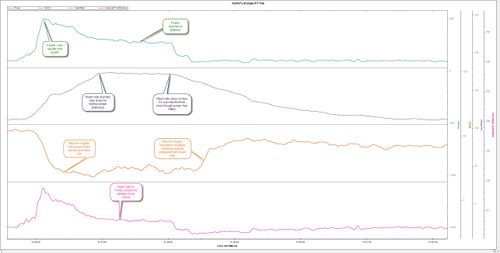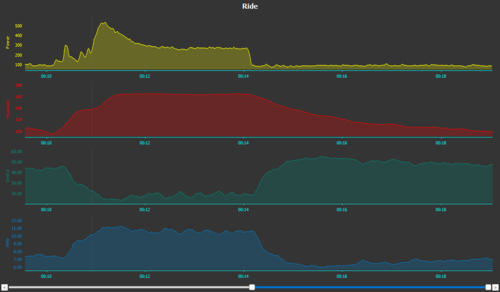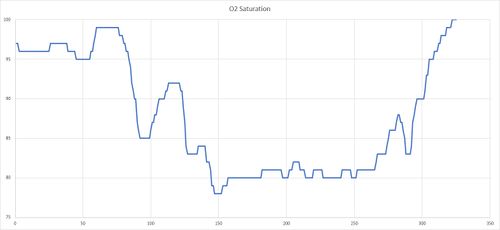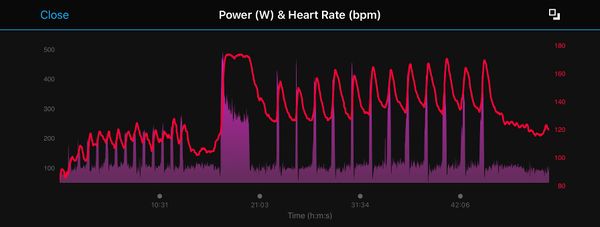3AOT, The 3-Minute All Out Test Workout
The 3-Minute All Out Test (3AOT) was developed as a way of estimating Critical Power. Using 3AOT as a test is covered under the Critical Power page. This article covers how to perform the 3AOT and the potential benefits of the 3AOT as a workout.
1 The 3AOT Concept
This is an "unpaced" test where you go all out for the duration of the test. That's different from most workouts where you keep the intensity steady for the duration. Instead of a steady effort, you go as hard as you can and then rapidly slow up as fatigue overwhelms you. Your power output should be very high for the first few seconds, then quickly drop to a plateau after about 2 minutes. The idea is that before the three minutes is up you will deplete all of your anaerobic capacity (W') and your power will be coming from aerobic sources only.
2 Performing the 3AOT
I strongly suggest that you perform the 3AOT on a stationary bike due to injury risk. You can read more about this at Cycling HIIT For Runners. The research studies tend to use different protocols for 3AOT, such as:
- First warm-up at 100w for ten minutes. Then you pedal for 30 seconds unloaded and increase your cadence to 110 rpm in the last ten seconds. After this "spin-up" you do the 3 Minute All Out Test against a fixed resistance. Finally, finish off with 5 minutes at 50w to cool down[1].
- First warm-up at 100w for just minutes, but then have 5 minutes rest. Then you pedal for 3 minutes unloaded and increase your cadence to 110 rpm in the last five seconds. After this "spin-up" you do the 3 Minute All Out Test against a fixed resistance[2].
The key takeaway here is that you need to warm up, but not too much. That's important when performing this as a critical power test, but less critical when using this as a workout. I'd suggest that it may be more important to warm-up thoroughly for injury prevention, even at the expense of the critical power values not being valid.
The pre-3AOT increase in cadence helps produce more initial power, as higher cadence seems to produce more power, with 110 RPM being the highest[3][4].
The next question is what resistance to set. For reasons that I hope are obvious, you can't set your trainer to ERG mode, which would keep the power output constant. The research studies have a lab that measure V̇O2max and some proxy for Lactate Threshold, and then set the resistance to produce the power output that your normal cadence that halfway between V̇O2max and Lactate Threshold. If you have a reasonable sense of your critical power, you could use that or you could estimate your power at V̇O2max as noted in Cycling HIIT For Runners.
For testing Critical Power, there must be no pacing or awareness of how much time is left, as even subconscious pacing will invalidate the test values. I'm not sure this is so much of an issue when doing a 3AOT when using it for training, but I put a sticky note over my timer.
One problem you may run into is that most software to control a bike trainer will either do fixed power by time, or resistance by distance, and you need resistance by time. One option is to set a simple timer for three minutes and manually change resistance at the end of the workout, but this is a pain. The only options I've found are the Tacx software and modifying Golden Cheetah. You can read more about this at Cycling HIIT For Runners.
Overheating could be a problem during 3AOT. If you're well trained, you may find your intensity is limited by your heat accumulation. If you're not well trained, that limitation may not apply and you could dangerously overheat, resulting in heatstroke. I have a high-powered fan that helps a little with cooling. Like any new exercise, I'd recommend trying the 3AOT without going "all out" so that you learn how it feels.
3 How the 3AOT Feels
The 3AOT is a tough workout, to put it mildly. No other workout fills me with a sense of dread like the 3AOT. The first few seconds are not too bad, but then the effort becomes extremely hard for the next 20-30 seconds. At that point, my power output and cadence start to drop, and there's a growing sense of being overwhelmed. The sensation as power output drops is strange, as I'm working as hard as I can, but the legs are not responding and there's a sense of weakness. Breathing and heart rate are maxed out, and I feel like I'm suffocating, with that "oxygen hunger" that leaves me with the sensation that there's no air in the room. I find that my vision changes, with that "seeing stars" effect that happens with low oxygen saturation. The final stages of the workout seem to last an eternity, and I always feel like the PC is broken and not changed the resistance at the end of the workout. After the workout, I need a protracted cooldown. It takes about 5 minutes for my breathing to return to some semblance of normality, even though my heart rate has come back down. I'm often a little shaky for hours later, though some of that might be due to elevated blood glucose that seems to occur after this workout. I've found that doing a series of mild intervals as part of the cooldown helps. I will do 15-second intervals at a fairly hard intensity, such as 1.5-2.0x my critical power, with 3 minutes at 100w, repeated for about 20-40 minutes. I think this helps burn off the lactate and lower blood glucose, but that's supposition on my part. This video shows an example of a 3AOT being used to estimate Critical Power.
4 Possible Benefits of 3AOT
The focus of 3AOT is measuring Critical Power, but having performed it a few times, I became interested in using it as a training workout. I see several characteristics of the 3AOT that make it useful.
- At the start of the 3AOT you are at maximum intensity, so it will provide a bit of the benefit by recruiting most of your muscle fibers. However, you are not at maximum power for long, so this is not a substitute for a maximum output HIIT.
- Your heart rate is maxed out for most of the workout, providing cardiac stress that should lead to adaptation. This is a relatively long time to have your heart rate at maximum, so I think this could be a strong stimulus.
- Your oxygen saturation can drop low for most of the workout, providing stress that should result in altitude like adaptations. During my 3AOT, I see both low peripheral oxygen saturation and low muscle oxygen saturation.
- Your blood lactate can be very high during the 3AOT. One study found average lactate levels of 11.0 mM[5]. That compares with Lactate Threshold (or more accurately Maximal Lactate Steady State) that is typically 4.0, with variations between 3.0 and 5.5.
- The last part of the 3AOT is close to V̇O2max, so all aspects of Oxygen delivery are maxed out. This should provide stimulus for adaptation of oxygen delivery, such as increased blood supply (angiogenesis.)
- The latter part of the 3AOT is an unusual situation, which I suspect may have unusual benefits. You are exercising aerobically, but with your anaerobic capacity depleted. There's no direct evidence concerning muscle fiber types that are recruited during a 3AOT. There's evidence that critical power is related to the percentage of slow twitch fibers[6], which makes sense. There's an assumption that the anerobic work of W' is from fast twitch fibers, but there's no correlation between W' and percent of fast twitch fibers[6]. In fact, while muscle recruitment falls during a 3AOT, it remains above the level seen at Critical Power[7]. I think this means that fast twitch fibers are being recruited but are being forced to work aerobically. My hope is that this will help drive muscle fiber conversion. The conversion of fast twitch to slow twitch seems possible[8], though research is currently limited. (Short sprint (10s) training without any endurance training can convert slow twitch to fast twitch[9], but the 3AOT test is much longer than that.)
- During the 3AOT, the muscles can become slightly acidic, with pH dropping to as low as 6.6[10]. It's unclear what the effects of this might be, though they could include vasoconstriction[11].
- A 3AOT can deplete Glycogen stores by about 35%[6]. This suggests a 3AOT can either be used to deplete Glycogen before endurance training to simulate a longer session or used after endurance training to further deplete Glycogen.
5 My 3AOT Workouts
I've added some graphs of the data I see during my 3AOT workouts. I've selected just the 3AOT section of the workout, ignoring the warmup and any subsequent training.
Here I'm using Golden Cheetah to overlay muscle oxygen data. You can see my heart rate in red and power in yellow. In addition, you can see my muscle oxygenation percent in green drop extremely low. It stays around 10-20% for the 3AOT, showing that my muscles are removing most of the oxygen from my blood. It shows that my muscles and blood are in a stead state for most of the workout. The blue line is the volume of deoxygenated blood, which is also at a steady state. You can see that my muscle oxygenation rebounds rapidly after the 3AOT, even though it takes longer for my heart rate to drop.
6 The 3AOT in Context
There are several stages to my typical 3AOT workout.
- I like to do a through warmup before a 3AOT, even if this leaves me with some depletion. I use short, mild intervals of increasing effort. These warmup intervals are 15 seconds with 45 second recoveries. The intervals go from an incline that requires just over 100 watts to requiring my critical power. I believe we need the higher intensity for an effective warmup, and simply cycling at 100 watts isn't effective.
- I then have a few minutes at a resistance that requires around 100 watts to prepare myself mentally.
- Just before the 3AOT itself, I drop resistance to zero incline, which is about 50 watts for my setup.
- The 3AOT follows, with resistance set to require ~20% over my Critical Power at my usual cadence. By spinning up my cadence higher, the initial power is well above my Critical Power.
- After the 3AOT I have a few minutes to partly recover.
- I perform a series of 15-second intervals with around 2-minute recoveries. These intervals are at a resistance that would require my critical power at my usual cadence. As much as possible, I try to push harder by increasing my cadence during the interval.
- A few minutes to cooldown at the end finish off the workout. I try to go for a walk after the workout to complete my cooldown.
7 References
- ↑ James Wright, Stewart Bruce-Low, Simon A. Jobson, The 3-minute all-out cycling test is sensitive to changes in cadence using the Lode Excalibur Sport ergometer, Journal of Sports Sciences, volume 37, issue 2, 2018, pages 156–162, ISSN 0264-0414, doi 10.1080/02640414.2018.1487115
- ↑ Anni Vanhatalo, Jonathan H. Doust, Mark Burnley, Determination of Critical Power Using a 3-min All-out Cycling Test, Medicine & Science in Sports & Exercise, volume 39, issue 3, 2007, pages 548–555, ISSN 0195-9131, doi 10.1249/mss.0b013e31802dd3e6
- ↑ N. McCartney, G. J. Heigenhauser, N. L. Jones, Power output and fatigue of human muscle in maximal cycling exercise, Journal of Applied Physiology, volume 55, issue 1, 1983, pages 218–224, ISSN 8750-7587, doi 10.1152/jappl.1983.55.1.218
- ↑ A. J. Sargeant, E. Hoinville, A. Young, Maximum leg force and power output during short-term dynamic exercise, Journal of Applied Physiology, volume 51, issue 5, 1981, pages 1175–1182, ISSN 8750-7587, doi 10.1152/jappl.1981.51.5.1175
- ↑ Mark Burnley, Jonathan H. Doust, Anni Vanhatalo, A 3-min All-Out Test to Determine Peak Oxygen Uptake and the Maximal Steady State, Medicine & Science in Sports & Exercise, volume 38, issue 11, 2006, pages 1995–2003, ISSN 0195-9131, doi 10.1249/01.mss.0000232024.06114.a6
- ↑ 6.0 6.1 6.2 Anni Vanhatalo, Matthew I. Black, Fred J. DiMenna, Jamie R. Blackwell, Jakob Friis Schmidt, Christopher Thompson, Lee J. Wylie, Magni Mohr, Jens Bangsbo, Peter Krustrup, Andrew M. Jones, The mechanistic bases of the power-time relationship: muscle metabolic responses and relationships to muscle fibre type, The Journal of Physiology, volume 594, issue 15, 2016, pages 4407–4423, ISSN 00223751, doi 10.1113/JP271879
- ↑ Anni Vanhatalo, David C. Poole, Fred J. DiMenna, Stephen J. Bailey, Andrew M. Jones, Muscle fiber recruitment and the slow component of O2 uptake: constant work rate vs. all-out sprint exercise, American Journal of Physiology-Regulatory, Integrative and Comparative Physiology, volume 300, issue 3, 2011, pages R700–R707, ISSN 0363-6119, doi 10.1152/ajpregu.00761.2010
- ↑ Jacob M. Wilson, Jeremy P. Loenneke, Edward Jo, Gabriel J. Wilson, Michael C. Zourdos, Jeong-Su Kim, The Effects of Endurance, Strength, and Power Training on Muscle Fiber Type Shifting, Journal of Strength and Conditioning Research, volume 26, issue 6, 2012, pages 1724–1729, ISSN 1064-8011, doi 10.1519/JSC.0b013e318234eb6f
- ↑ M. Esbjörnsson, Y. Hellsten-Westing, P. D. Balsom, B. Sjödin, E. Jansson, Muscle fibre type changes with sprint training: effect of training pattern, Acta Physiologica Scandinavica, volume 149, issue 2, 1993, pages 245–246, ISSN 00016772, doi 10.1111/j.1748-1716.1993.tb09618.x
- ↑ H. B. Rossiter, S. A. Ward, J. M. Kowalchuk, F. A. Howe, J. R. Griffiths, B. J. Whipp, Dynamic asymmetry of phosphocreatine concentration and O2uptake between the on- and off-transients of moderate- and high-intensity exercise in humans, The Journal of Physiology, volume 541, issue 3, 2002, pages 991–1002, ISSN 00223751, doi 10.1113/jphysiol.2001.012910
- ↑ L. Sinoway, S. Prophet, I. Gorman, T. Mosher, J. Shenberger, M. Dolecki, R. Briggs, R. Zelis, Muscle acidosis during static exercise is associated with calf vasoconstriction, Journal of Applied Physiology, volume 66, issue 1, 1989, pages 429–436, ISSN 8750-7587, doi 10.1152/jappl.1989.66.1.429




